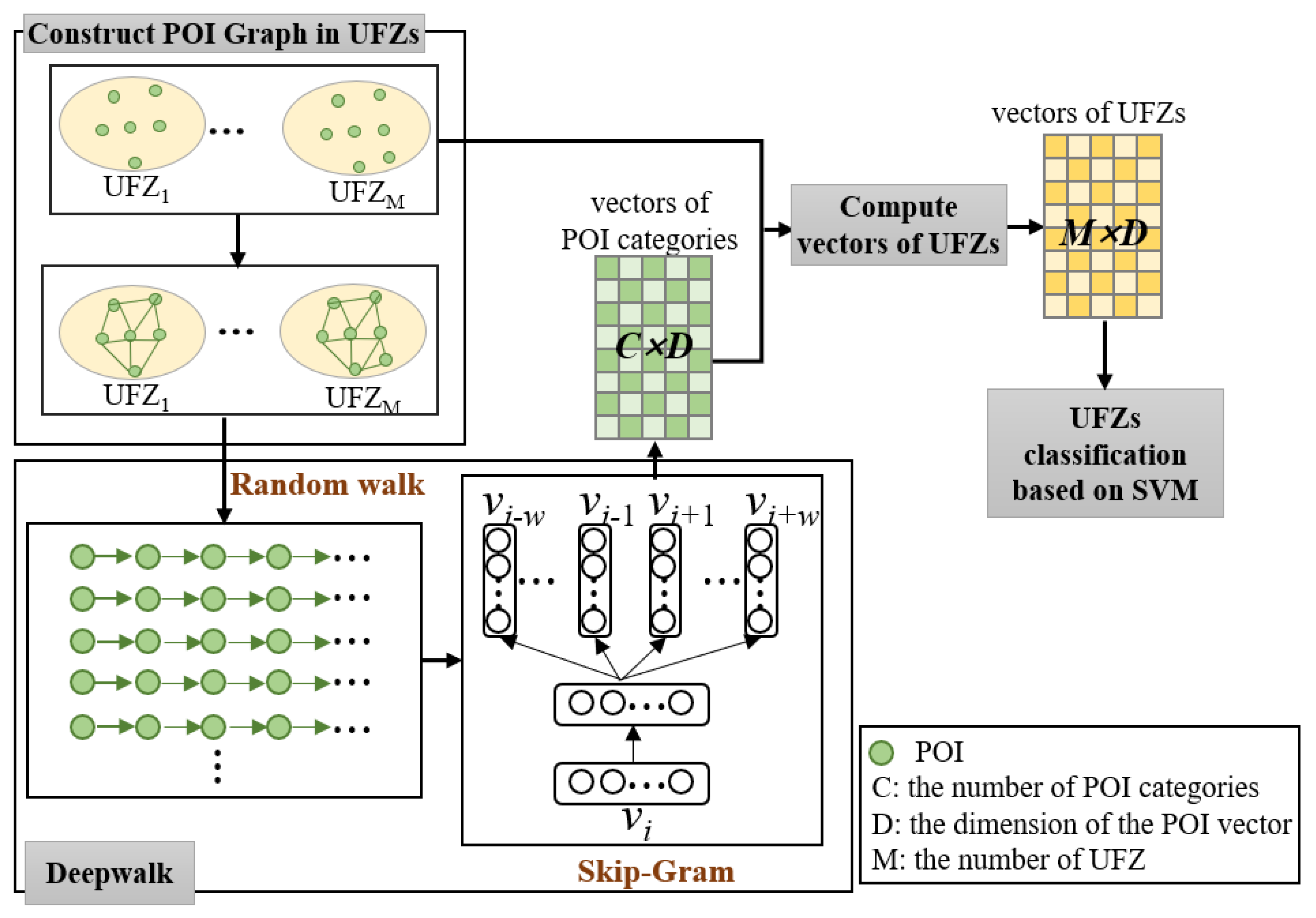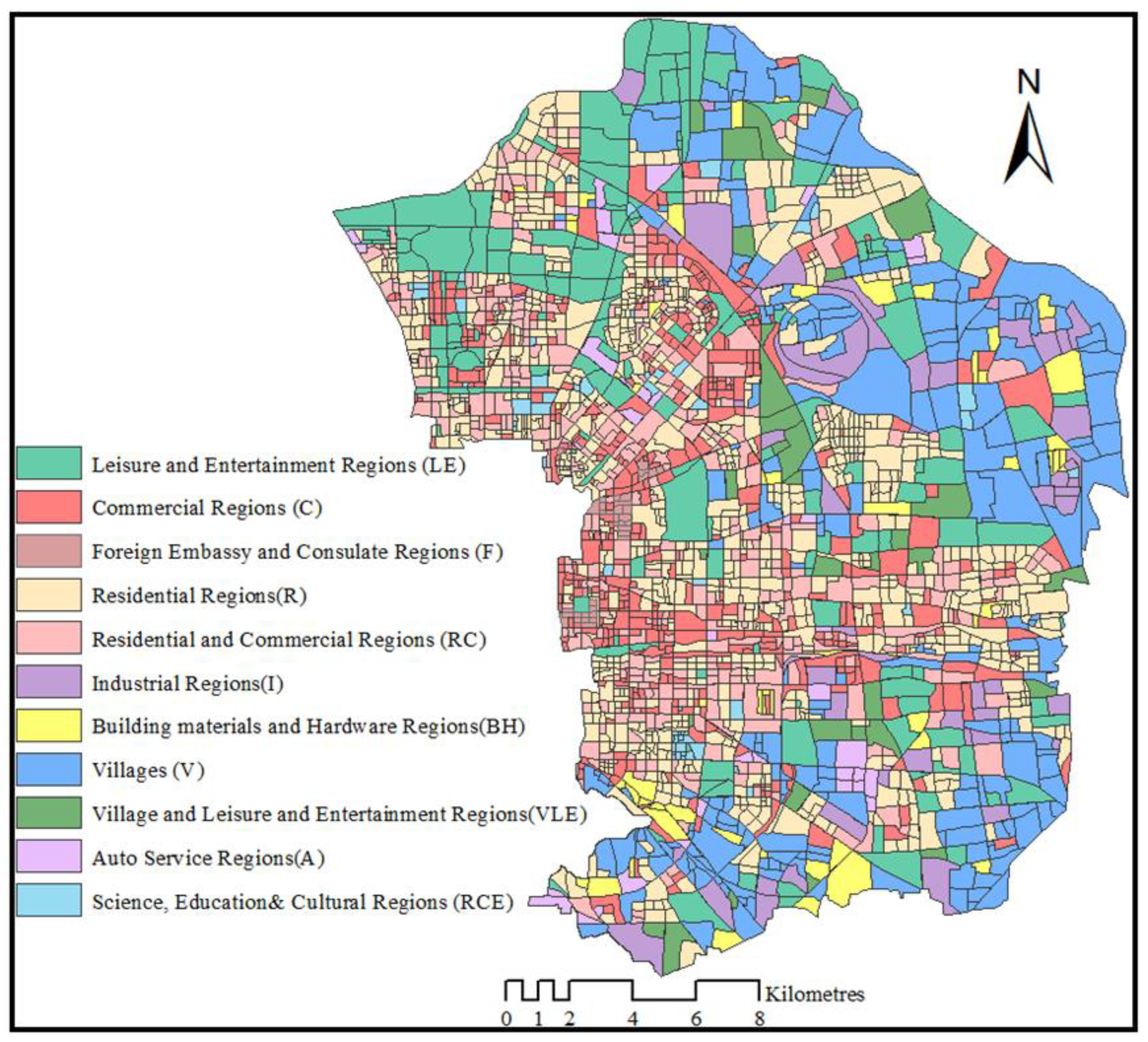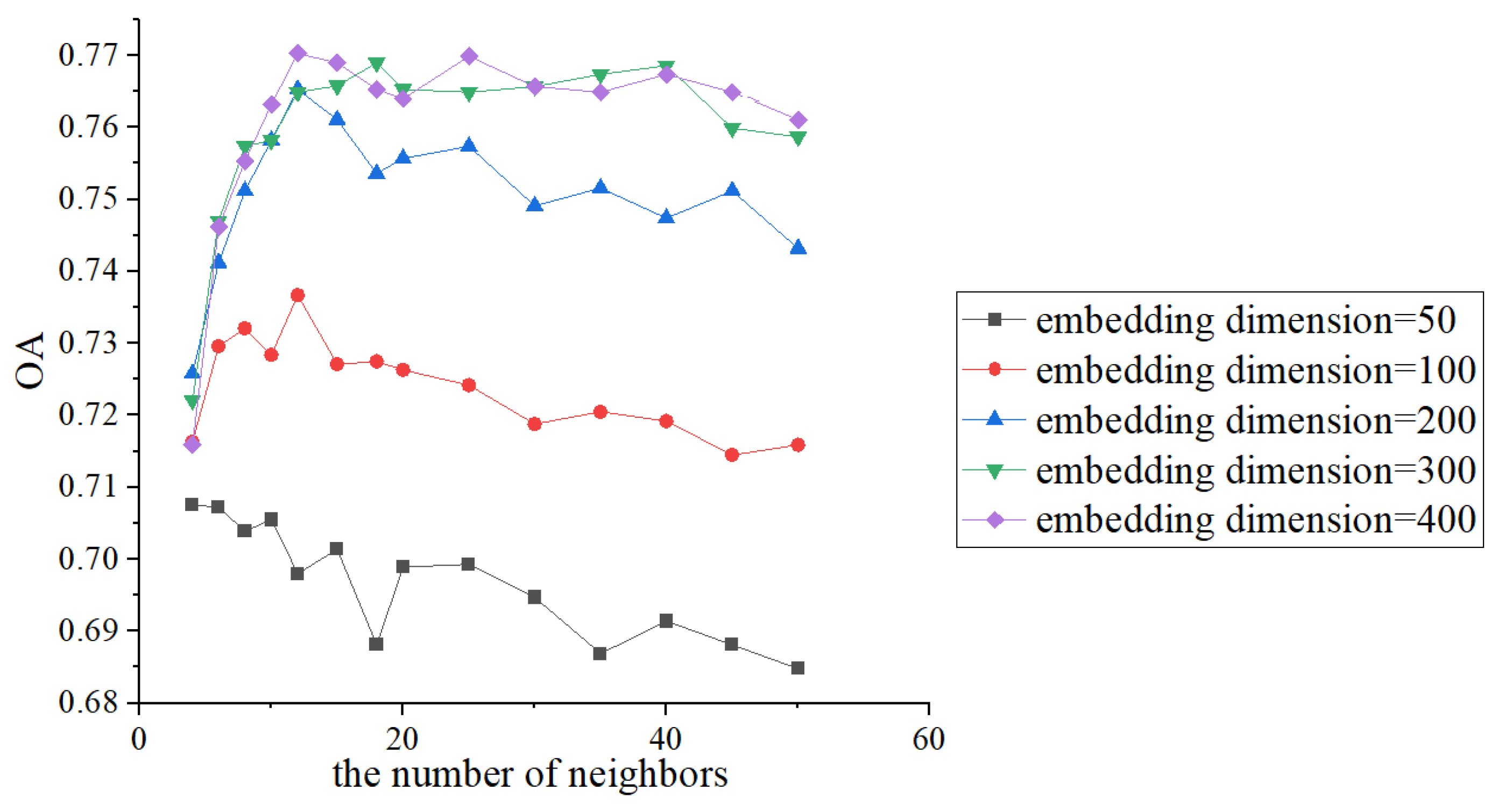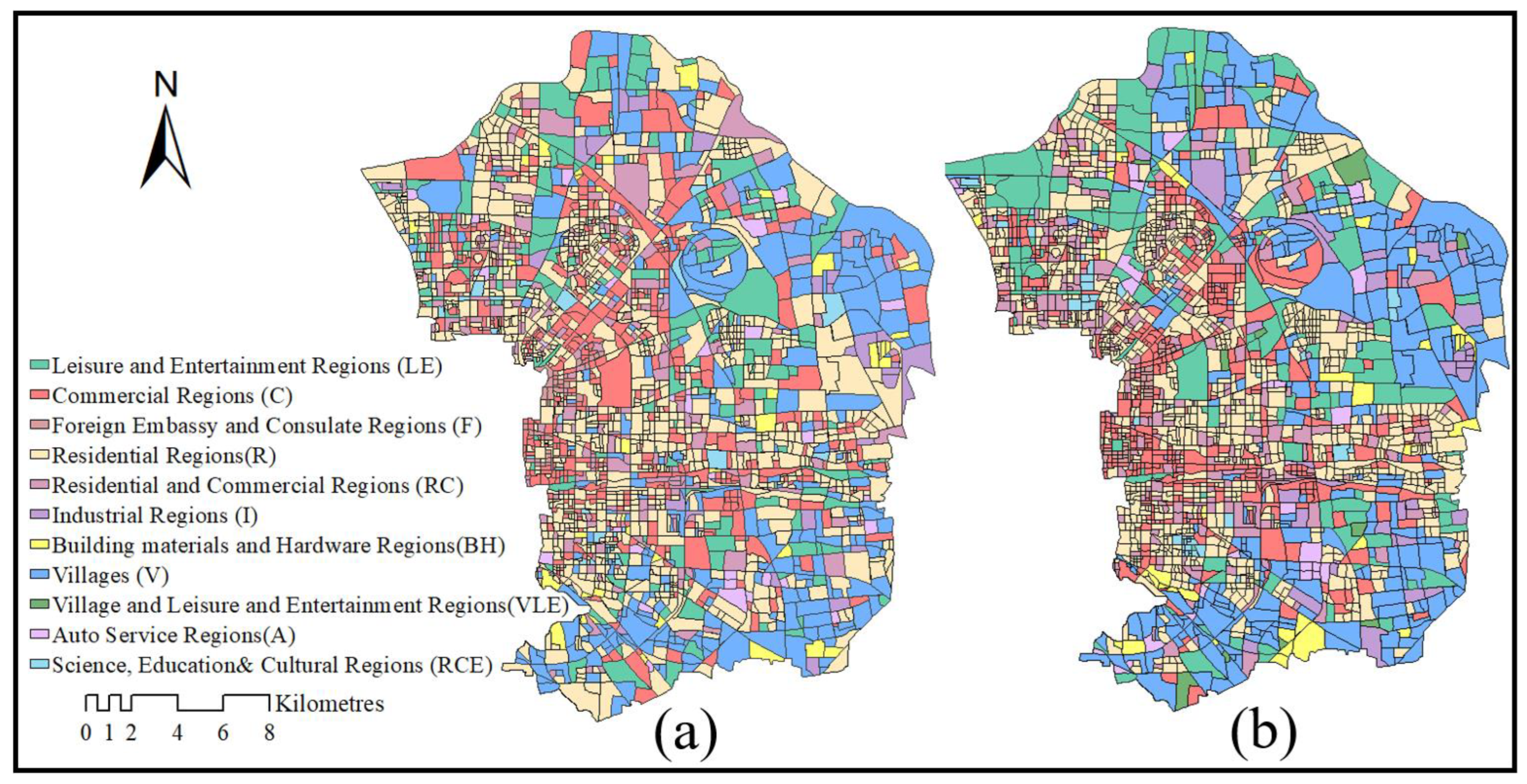Classifying Urban Functional Zones Based on Modeling POIs by Deepwalk
Abstract
1. Introduction
2. Methodology
2.1. Constructing POI Graphs in UFZs
2.2. Embedding POI Type in Vector Space Based on Deepwalk
2.3. Embedding Urban Functional Zone in Vector Space
2.4. Classifying Urban Functional Zone Using SVM
3. Case Study
3.1. Data Source
3.2. Result
3.2.1. Parameters Sensitivity Analysis
3.2.2. Result Analysis
3.3. Comparison
4. Conclusions
Author Contributions
Funding
Institutional Review Board Statement
Informed Consent Statement
Data Availability Statement
Acknowledgments
Conflicts of Interest
References
- Yuan, N.J.; Zheng, Y.; Xie, X.; Wang, Y.Z.; Zheng, K.; Xiong, H. Discovering Urban Functional Zones Using Latent Activity Trajectories. IEEE Trans. Knowl. Data Eng. 2014, 27, 712–725. [Google Scholar] [CrossRef]
- Liu, B.H.; Deng, Y.B.; Li, M.; Yang, J.; Liu, T. Classification Schemes and Identification Methods for Urban Functional Zone: A Review of Recent Papers. Appl. Sci. 2021, 11, 9968. [Google Scholar] [CrossRef]
- Wang, Y.D.; Gu, Y.Y.; Dou, M.X.; Qiao, M.L. Using spatial semantics and interactions to identify urban functional regions. ISPRS Int. J. Geo-Inf. 2018, 7, 130. [Google Scholar] [CrossRef]
- Cai, L.; Zhang, L.Q.Y.; Liang, Y.; Li, J. Discovery of urban functional regions based on Node2vec. Appl. Intell. 2022, 52, 16886–16899. [Google Scholar] [CrossRef]
- Zhang, Y.; Li, Q.; Tu, W.; Mai, K.; Yao, Y.; Chen, Y.Y. Functional urban land use recognition integrating multi-source geospatial data and cross-correlations. Comput. Environ. Urban Syst. 2019, 78, 101374. [Google Scholar] [CrossRef]
- Zhang, X.Y.; Du, S.H.; Wang, Q.; Zhou, W.Q. Multiscale Geoscene Segmentation for Extracting Urban Functional Zones from VHR Satellite Images. Remote Sens. 2018, 10, 281. [Google Scholar] [CrossRef]
- Huang, X.; Hu, T.; Li, J. Mapping urban areas in China using multisource data with a novel ensemble SVM method. IEEE J. Sel. Top. Appl. Earth Observ. Remote Sens. 2018, 56, 4258–4273. [Google Scholar] [CrossRef]
- Xu, S.Y.; Qing, L.B.; Han, L.M.; Liu, M.; Peng, Y.H.; Shen, L.F. A New Remote Sensing Images and Point-of-Interest Fused (RPF) Model for Sensing Urban Functional Regions. Remote. Sens. 2020, 12, 1032. [Google Scholar] [CrossRef]
- Wu, J.J.; Zhang, J.; Zhang, H.X. Urban Functional Area Recognition Based on Unbalanced Clustering. Math. Probl. Eng. 2022, 2022, 7245407. [Google Scholar] [CrossRef]
- Huang, S.Z. Evolution of City Functional Layout of Beijing in the 1990S. Beijing Plan. Constr. 2003, 3, 22–25. [Google Scholar]
- Andrade, R.; Alves, A.; Bento, C. POI Mining for Land Use Classification: A Case Study. ISPRS Int. J. Geo-Inf. 2020, 9, 493. [Google Scholar] [CrossRef]
- Wang, Z.Y.; Ma, D.B.; Sun, D.Q.; Zhang, J.X. Identification and analysis of urban functional area in Hangzhou based on OSM and POI data. PLoS ONE 2021, 16, e0251988. [Google Scholar] [CrossRef]
- Chen, Y.; Chen, X.; Liu, Z. Understanding the spatial organization of urban functions based on co-location patterns mining: A comparative analysis for 25 Chinese cities. Cities 2020, 97, 102563. [Google Scholar] [CrossRef]
- Hu, Y.F.; Han, Y.Q. Identification of Urban Functional Areas Based on POI Data: A Case Study of the Guangzhou Economic and Technological Development Zone. Sustainability 2019, 11, 1385. [Google Scholar] [CrossRef]
- Yao, Y.; Li, X.; Liu, X.; Liu, P.; Liang, Z.; Zhang, J.; Mai, K. Sensing spatial distribution of urban land use by integrating points-of-interest and Google Word2Vec model. Int. J. Geogr. Inf. Sci. 2017, 31, 825–848. [Google Scholar] [CrossRef]
- Chen, Y.; Qian, H.Z.; Wang, X.; Wang, D.; Han, L.J. A GloVe Model for Urban Functional Area Identification Considering Nonlinear Spatial Relationships between Points of Interest. ISPRS Int. J. Geo-Inf. 2022, 11, 498. [Google Scholar] [CrossRef]
- Chen, Z.L.; Zhou, L.L.; Yu, W.H. Identification of the urban functional regions considering the potential context of interest points. Acta Geod. Cartogr. Sin. 2020, 49, 907–920. [Google Scholar]
- Crooks, A.; Pfoser, D.; Jenkins, A. Crowdsourcing urban form and function. Int. J. Geogr. Inf. Sci. 2015, 29, 720–741. [Google Scholar] [CrossRef]
- Liu, X.; He, J.; Yao, Y. Classifying urban land use by integrating remote sensing and social media data. Int. J. Geogr. Inf. Sci. 2017, 31, 1675–1696. [Google Scholar] [CrossRef]
- Du, S.J.; Du, S.H.; Liu, B.; Zhang, X.Y.; Zheng, Z.J. Large-scale urban functional zone mapping by integrating remote sensing images and open social data. GISci. Remote Sens. 2020, 57, 411–430. [Google Scholar] [CrossRef]
- Cao, K.; Guo, H.; Zhang, Y. Comparison of Approaches for Urban Functional Zones Classification Based on Multi-Source Geospatial Data: A Case Study in Yuzhong District, Chongqing, China. Sustainability 2019, 11, 660. [Google Scholar] [CrossRef]
- Lu, W.P.; Tao, C.; Li, H.F.; Qi, J.; Li, Y.S. A unified deep learning framework for urban functional zone extraction based on multi-source heterogeneous data. Remote Sens. Environ. 2022, 270, 112830. [Google Scholar] [CrossRef]
- Bao, H.Q.; Ming, D.P.; Guo, Y.; Zhang, K.; Zhou, K.Q.; Du, S.G. DFCNN-Based Semantic Recognition of Urban Functional Zones by Integrating Remote Sensing Data and POI Data. Remote Sens. 2020, 12, 1088. [Google Scholar] [CrossRef]
- Feng, Y.; Huang, Z.; Wang, Y.L.; Wan, L.; Liu, Y.; Zhang, Y.; Shan, X. An SOE-based learning framework using multisource big data for identifying urban functional zones. IEEE J. Sel. Top. Appl. Earth Observ. Remote Sens. 2021, 14, 7336–7348. [Google Scholar] [CrossRef]
- Hu, S.; He, Z.; Wu, L.; Yin, L.; Xu, Y.; Cui, H. A framework for extracting urban functional regions based on multiprototype word embeddings using points-of-interest data. Comput. Environ. Urban Syst. 2020, 80, 101442. [Google Scholar] [CrossRef]
- Niu, H.F.; Elisabete, A.S. Delineating urban functional use from points of interest data with neural network embedding: A case study in Greater London. Comput. Environ. Urban Syst. 2021, 88, 101651. [Google Scholar] [CrossRef]
- Yan, B. From ITDL to Place2Vec–Reasoning About Place Type Similarity and Relatedness by Learning Embeddings from Augmented Spatial Contexts. In Proceedings of the 25th ACM SIGSPATIAL International Conference on Advances in Geographic Information Systems, Redondo Beach, CA, USA, 7–10 November 2017; Volume 35. [Google Scholar]
- Zhai, W.; Bai, X.; Shi, Y.; Han, Y.; Peng, Z.R.; Gu, C. Beyond Word2vec: An approach for urban functional region extraction and identification by combining Place2vec and POIs. Comput. Environ. Urban Syst. 2019, 74, 1–12. [Google Scholar] [CrossRef]
- Sun, Z.H.; Jiao, H.Z.; Wu, H.; Peng, Z.H.; Liu, L.B. Block2vec: An Approach for Identifying Urban Functional Regions by Integrating Sentence Embedding Model and Points of Interest. ISPRS Int. J. Geo-Inf. 2021, 10, 339. [Google Scholar] [CrossRef]
- Yang, K.; Zhu, J.H. Next POI Recommendation via Graph Embedding Representation From H-Deepwalk on Hybrid Network. IEEE Access 2019, 7, 171105–171113. [Google Scholar] [CrossRef]
- Li, Q.; Xiao, F.; An, L.; Long, X.Z.; Sun, X.C. Semantic Concept Network and Deep Walk-based Visual Question Answering. ACM Trans. Multimed. Comput. Commun. Appl. 2019, 15, 1–19. [Google Scholar] [CrossRef]
- Berahmand, K.; Nasiri, E.; Rostami, M.; Forouzandeh, S. A modified DeepWalk method for link prediction in attributed social network. Computing 2021, 103, 2227–2249. [Google Scholar] [CrossRef]
- Chen, Y.F.; Wang, L.; Qi, D.H.; Ma, T.H.; Zhang, W. Community Detection Based on DeepWalk Model in Large-Scale Networks. Secur. Commun. Networks 2020, 2020, 8845942. [Google Scholar] [CrossRef]
- Yu, H.T.; Ma, R.; Chao, J.B.; Zhang, F.Z. An Overlapping Community Detection Approach Based on Deepwalk and Improved Label Propagation. IEEE Trans. Comput. Soc. Syst. 2023, 10, 311–321. [Google Scholar]
- Yang, J.; Li, J.H.; Wei, L.; Gao, L.; Mao, F.Q. Spatiotemporal DeepWalk Gated Recurrent Neural Network: A Deep Learning Framework for Traffic Learning and Forecasting. J. Adv. Transp. 2022, 2022, 4260244. [Google Scholar] [CrossRef]
- Chen, Z.H.; You, Z.H.; Guo, Z.H.; Yi, H.C.; Luo, G.X.; Wang, Y.B. Prediction of Drug-Target Interactions from Multi-Molecular Network Based on Deep Walk Embedding Model. Front. Bioeng. Biotechnol. 2020, 8, 338. [Google Scholar] [CrossRef]
- Zhao, P.; Luo, A.; Liu, Y. Where to go next: A spatio-temporal gated network for next poi recommendation. IEEE Trans. Knowl. Data Eng. 2020, 99, 2512–2524. [Google Scholar]







| V | VLE | R | RC | BH | I | C | LE | RCE | A | F | |
|---|---|---|---|---|---|---|---|---|---|---|---|
| V | 0.791 | 0.281 | 0.017 | 0.025 | 0.138 | 0.127 | 0.054 | 0.023 | 0.053 | 0.098 | 0.000 |
| VLE | 0.005 | 0.469 | 0.001 | 0.003 | 0.000 | 0.000 | 0.002 | 0.023 | 0.000 | 0.000 | 0.000 |
| R | 0.104 | 0.000 | 0.917 | 0.290 | 0.034 | 0.000 | 0.106 | 0.058 | 0.140 | 0.000 | 0.000 |
| RC | 0.005 | 0.031 | 0.037 | 0.553 | 0.017 | 0.000 | 0.052 | 0.012 | 0.053 | 0.024 | 0.027 |
| BH | 0.014 | 0.031 | 0.000 | 0.005 | 0.586 | 0.018 | 0.004 | 0.006 | 0.018 | 0.000 | 0.000 |
| I | 0.019 | 0.000 | 0.002 | 0.000 | 0.103 | 0.709 | 0.019 | 0.012 | 0.000 | 0.000 | 0.000 |
| C | 0.043 | 0.125 | 0.020 | 0.118 | 0.103 | 0.127 | 0.745 | 0.047 | 0.018 | 0.122 | 0.000 |
| LE | 0.019 | 0.063 | 0.002 | 0.003 | 0.017 | 0.000 | 0.004 | 0.789 | 0.000 | 0.024 | 0.000 |
| RCE | 0.000 | 0.000 | 0.002 | 0.000 | 0.000 | 0.000 | 0.009 | 0.023 | 0.719 | 0.000 | 0.000 |
| A | 0.000 | 0.000 | 0.001 | 0.003 | 0.000 | 0.018 | 0.004 | 0.006 | 0.053 | 0.732 | 0.000 |
| F | 0.000 | 0.000 | 0.000 | 0.000 | 0.000 | 0.000 | 0.000 | 0.000 | 0.053 | 0.000 | 0.973 |
| Word2vec Model | Place2vec Model | The Proposed Method | |
|---|---|---|---|
| V | 0.649 | 0.787 | 0.791 |
| VLE | 0.000 | 0.281 | 0.469 |
| R | 0.887 | 0.914 | 0.917 |
| RC | 0.411 | 0.512 | 0.553 |
| BH | 0.466 | 0.500 | 0.586 |
| I | 0.273 | 0.618 | 0.709 |
| C | 0.674 | 0.732 | 0.745 |
| LE | 0.696 | 0.766 | 0.789 |
| RCE | 0.632 | 0.754 | 0.719 |
| A | 0.610 | 0.707 | 0.732 |
| F | 0.973 | 0.973 | 0.973 |
| OA | 0.694 | 0.765 | 0.784 |
| Kappa | 0.598 | 0.694 | 0.718 |
Disclaimer/Publisher’s Note: The statements, opinions and data contained in all publications are solely those of the individual author(s) and contributor(s) and not of MDPI and/or the editor(s). MDPI and/or the editor(s) disclaim responsibility for any injury to people or property resulting from any ideas, methods, instructions or products referred to in the content. |
© 2023 by the authors. Licensee MDPI, Basel, Switzerland. This article is an open access article distributed under the terms and conditions of the Creative Commons Attribution (CC BY) license (https://creativecommons.org/licenses/by/4.0/).
Share and Cite
Yang, X.; Bo, S.; Zhang, Z. Classifying Urban Functional Zones Based on Modeling POIs by Deepwalk. Sustainability 2023, 15, 7995. https://doi.org/10.3390/su15107995
Yang X, Bo S, Zhang Z. Classifying Urban Functional Zones Based on Modeling POIs by Deepwalk. Sustainability. 2023; 15(10):7995. https://doi.org/10.3390/su15107995
Chicago/Turabian StyleYang, Xin, Shuaishuai Bo, and Zhaojie Zhang. 2023. "Classifying Urban Functional Zones Based on Modeling POIs by Deepwalk" Sustainability 15, no. 10: 7995. https://doi.org/10.3390/su15107995
APA StyleYang, X., Bo, S., & Zhang, Z. (2023). Classifying Urban Functional Zones Based on Modeling POIs by Deepwalk. Sustainability, 15(10), 7995. https://doi.org/10.3390/su15107995







